Adidas Project Development & Optimization: A Comprehensive Report
VerifiedAdded on 2023/06/07
|17
|5087
|251
Report
AI Summary
This report presents a comprehensive analysis of Adidas' project development and optimization strategies. It begins with a sensitivity analysis, justifying key parameters, measurement processes, and their usefulness with real-life examples. Scenario analysis is then applied to two potential Adidas projects, focusing on time and cost factors, along with economic analysis and risk mitigation strategies. The report also details the due diligence procedure specific to Adidas and provides information on relevant stakeholders. Ultimately, this document offers a thorough overview of project considerations for Adidas, aiming to provide insights for stakeholders.

Running Head: PROJECT DEVELOPMENT AND OPTIMIZATION
PROJECT DEVELOPMENT AND OPTIMIZATION
PROJECT DEVELOPMENT AND OPTIMIZATION
Paraphrase This Document
Need a fresh take? Get an instant paraphrase of this document with our AI Paraphraser
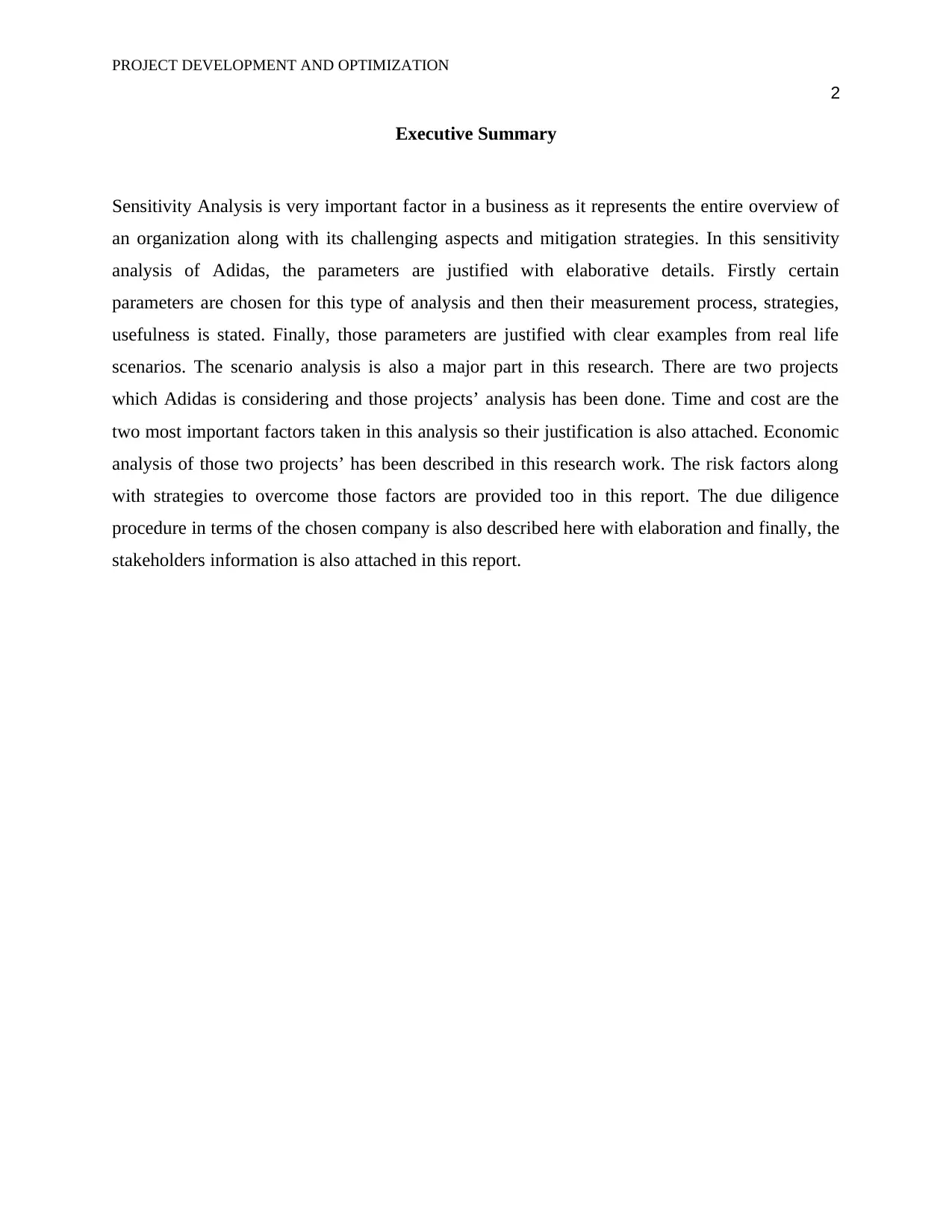
PROJECT DEVELOPMENT AND OPTIMIZATION
2
Executive Summary
Sensitivity Analysis is very important factor in a business as it represents the entire overview of
an organization along with its challenging aspects and mitigation strategies. In this sensitivity
analysis of Adidas, the parameters are justified with elaborative details. Firstly certain
parameters are chosen for this type of analysis and then their measurement process, strategies,
usefulness is stated. Finally, those parameters are justified with clear examples from real life
scenarios. The scenario analysis is also a major part in this research. There are two projects
which Adidas is considering and those projects’ analysis has been done. Time and cost are the
two most important factors taken in this analysis so their justification is also attached. Economic
analysis of those two projects’ has been described in this research work. The risk factors along
with strategies to overcome those factors are provided too in this report. The due diligence
procedure in terms of the chosen company is also described here with elaboration and finally, the
stakeholders information is also attached in this report.
2
Executive Summary
Sensitivity Analysis is very important factor in a business as it represents the entire overview of
an organization along with its challenging aspects and mitigation strategies. In this sensitivity
analysis of Adidas, the parameters are justified with elaborative details. Firstly certain
parameters are chosen for this type of analysis and then their measurement process, strategies,
usefulness is stated. Finally, those parameters are justified with clear examples from real life
scenarios. The scenario analysis is also a major part in this research. There are two projects
which Adidas is considering and those projects’ analysis has been done. Time and cost are the
two most important factors taken in this analysis so their justification is also attached. Economic
analysis of those two projects’ has been described in this research work. The risk factors along
with strategies to overcome those factors are provided too in this report. The due diligence
procedure in terms of the chosen company is also described here with elaboration and finally, the
stakeholders information is also attached in this report.
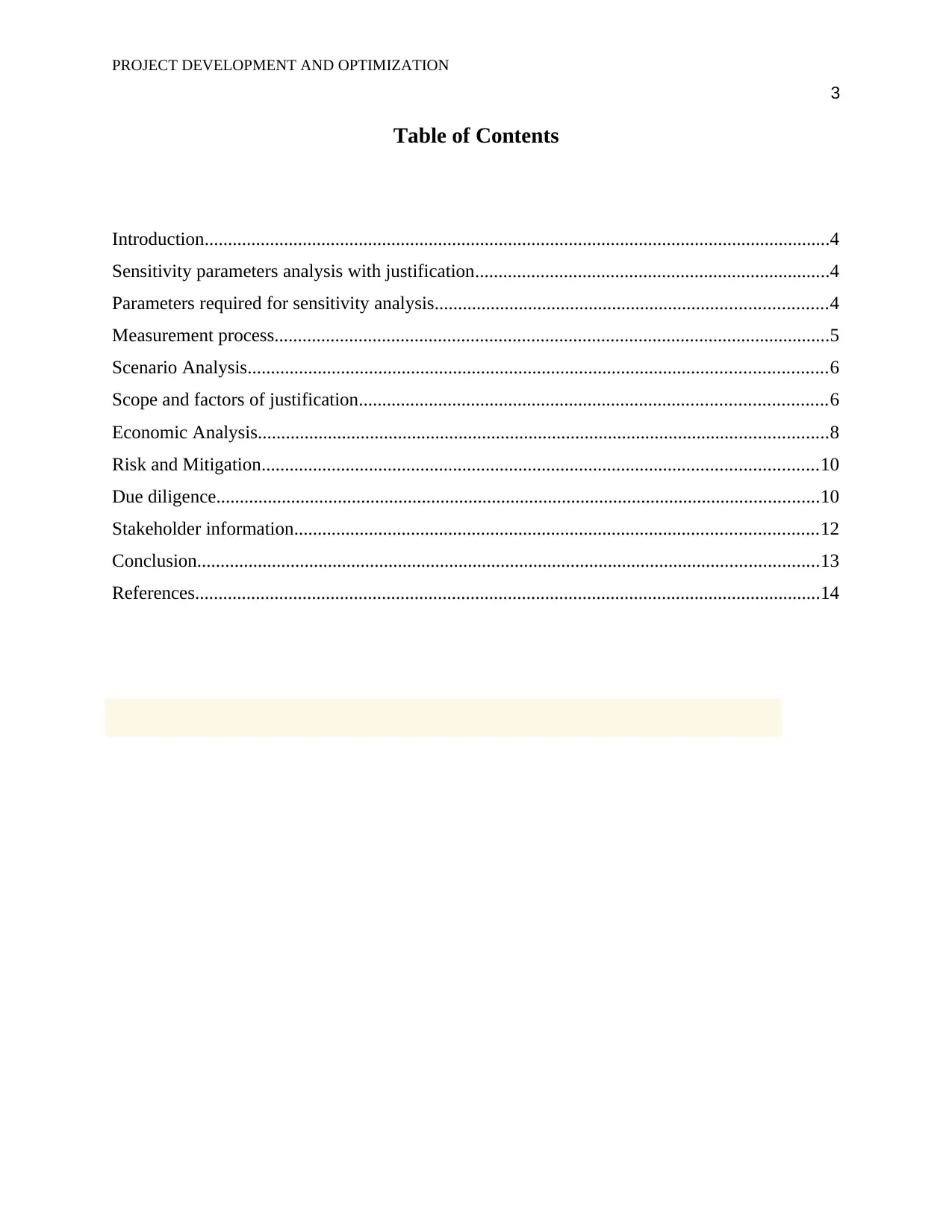
PROJECT DEVELOPMENT AND OPTIMIZATION
3
Table of Contents
Introduction......................................................................................................................................4
Sensitivity parameters analysis with justification............................................................................4
Parameters required for sensitivity analysis....................................................................................4
Measurement process.......................................................................................................................5
Scenario Analysis............................................................................................................................6
Scope and factors of justification....................................................................................................6
Economic Analysis..........................................................................................................................8
Risk and Mitigation.......................................................................................................................10
Due diligence.................................................................................................................................10
Stakeholder information................................................................................................................12
Conclusion.....................................................................................................................................13
References......................................................................................................................................14
3
Table of Contents
Introduction......................................................................................................................................4
Sensitivity parameters analysis with justification............................................................................4
Parameters required for sensitivity analysis....................................................................................4
Measurement process.......................................................................................................................5
Scenario Analysis............................................................................................................................6
Scope and factors of justification....................................................................................................6
Economic Analysis..........................................................................................................................8
Risk and Mitigation.......................................................................................................................10
Due diligence.................................................................................................................................10
Stakeholder information................................................................................................................12
Conclusion.....................................................................................................................................13
References......................................................................................................................................14
⊘ This is a preview!⊘
Do you want full access?
Subscribe today to unlock all pages.

Trusted by 1+ million students worldwide
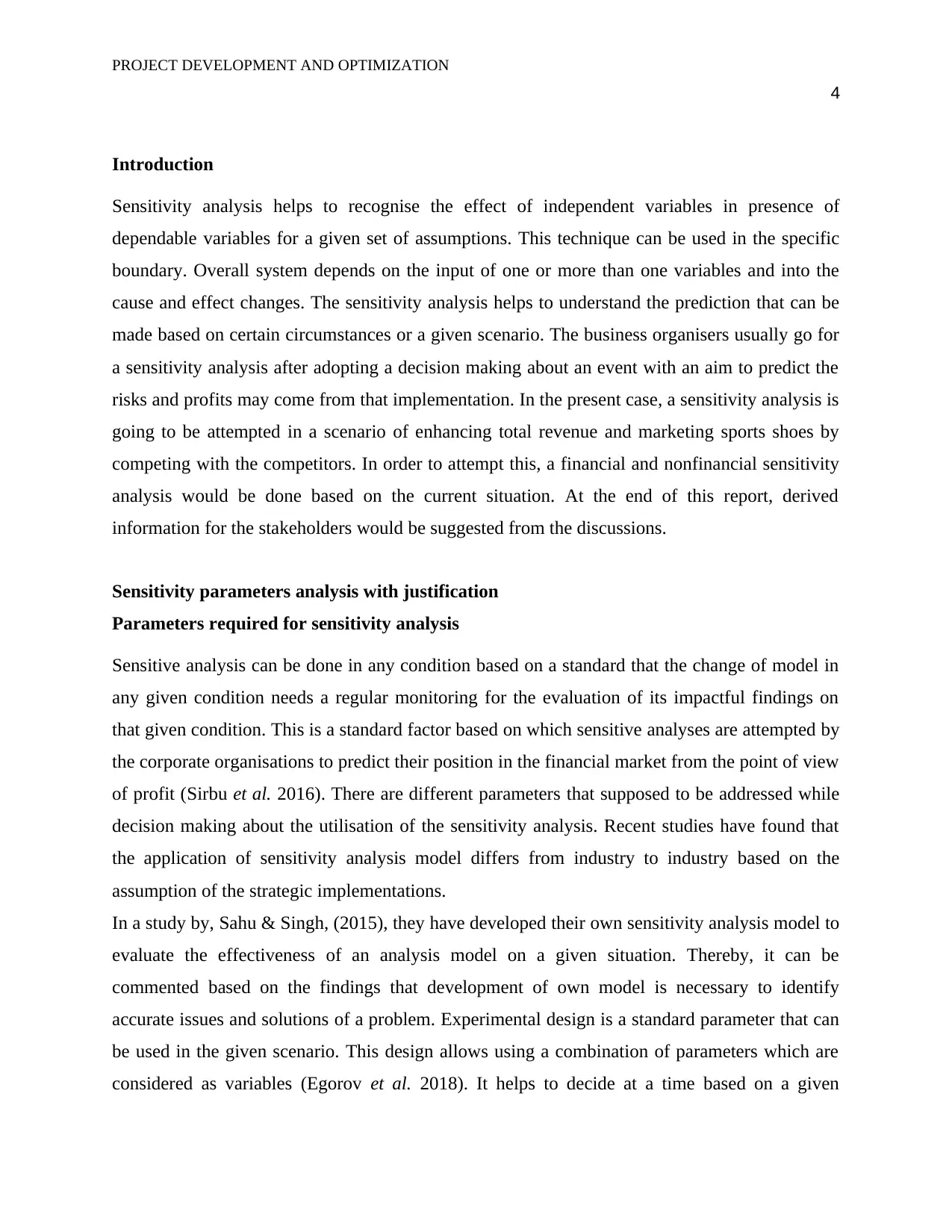
PROJECT DEVELOPMENT AND OPTIMIZATION
4
Introduction
Sensitivity analysis helps to recognise the effect of independent variables in presence of
dependable variables for a given set of assumptions. This technique can be used in the specific
boundary. Overall system depends on the input of one or more than one variables and into the
cause and effect changes. The sensitivity analysis helps to understand the prediction that can be
made based on certain circumstances or a given scenario. The business organisers usually go for
a sensitivity analysis after adopting a decision making about an event with an aim to predict the
risks and profits may come from that implementation. In the present case, a sensitivity analysis is
going to be attempted in a scenario of enhancing total revenue and marketing sports shoes by
competing with the competitors. In order to attempt this, a financial and nonfinancial sensitivity
analysis would be done based on the current situation. At the end of this report, derived
information for the stakeholders would be suggested from the discussions.
Sensitivity parameters analysis with justification
Parameters required for sensitivity analysis
Sensitive analysis can be done in any condition based on a standard that the change of model in
any given condition needs a regular monitoring for the evaluation of its impactful findings on
that given condition. This is a standard factor based on which sensitive analyses are attempted by
the corporate organisations to predict their position in the financial market from the point of view
of profit (Sirbu et al. 2016). There are different parameters that supposed to be addressed while
decision making about the utilisation of the sensitivity analysis. Recent studies have found that
the application of sensitivity analysis model differs from industry to industry based on the
assumption of the strategic implementations.
In a study by, Sahu & Singh, (2015), they have developed their own sensitivity analysis model to
evaluate the effectiveness of an analysis model on a given situation. Thereby, it can be
commented based on the findings that development of own model is necessary to identify
accurate issues and solutions of a problem. Experimental design is a standard parameter that can
be used in the given scenario. This design allows using a combination of parameters which are
considered as variables (Egorov et al. 2018). It helps to decide at a time based on a given
4
Introduction
Sensitivity analysis helps to recognise the effect of independent variables in presence of
dependable variables for a given set of assumptions. This technique can be used in the specific
boundary. Overall system depends on the input of one or more than one variables and into the
cause and effect changes. The sensitivity analysis helps to understand the prediction that can be
made based on certain circumstances or a given scenario. The business organisers usually go for
a sensitivity analysis after adopting a decision making about an event with an aim to predict the
risks and profits may come from that implementation. In the present case, a sensitivity analysis is
going to be attempted in a scenario of enhancing total revenue and marketing sports shoes by
competing with the competitors. In order to attempt this, a financial and nonfinancial sensitivity
analysis would be done based on the current situation. At the end of this report, derived
information for the stakeholders would be suggested from the discussions.
Sensitivity parameters analysis with justification
Parameters required for sensitivity analysis
Sensitive analysis can be done in any condition based on a standard that the change of model in
any given condition needs a regular monitoring for the evaluation of its impactful findings on
that given condition. This is a standard factor based on which sensitive analyses are attempted by
the corporate organisations to predict their position in the financial market from the point of view
of profit (Sirbu et al. 2016). There are different parameters that supposed to be addressed while
decision making about the utilisation of the sensitivity analysis. Recent studies have found that
the application of sensitivity analysis model differs from industry to industry based on the
assumption of the strategic implementations.
In a study by, Sahu & Singh, (2015), they have developed their own sensitivity analysis model to
evaluate the effectiveness of an analysis model on a given situation. Thereby, it can be
commented based on the findings that development of own model is necessary to identify
accurate issues and solutions of a problem. Experimental design is a standard parameter that can
be used in the given scenario. This design allows using a combination of parameters which are
considered as variables (Egorov et al. 2018). It helps to decide at a time based on a given
Paraphrase This Document
Need a fresh take? Get an instant paraphrase of this document with our AI Paraphraser

PROJECT DEVELOPMENT AND OPTIMIZATION
5
condition how many parameters can be used by assigning the maximum and minimum values
before the experiment. Thus, the successful evaluation of the findings of this study could help to
build up a positive or negative correlation along with the assigned values in combination with a
situation. In the given context it can be assumed that for the project A with an aim of enhancing
revenue the company has introduced a product with new pricing and promotion strategy. On the
other hand with an aim of determining the profit from the newly launched sports shoe, the
profitability variables have considered. Again, both the variables have their own other
distinguishing variables that can be correlated with the variables of each other (Tezaur et al.
2015). Thus, it can be stated that the use of a combination of parameters through experimental
design can be considered as an effective way of evaluating important findings of this study.
Another important measure or parameter for the given scenario can be the ‘what to observe’
parameter. Usefulness of this parameter relies upon the utilisation of value of objectives based on
the strategic implementations, values of the decisions variables and also the effectiveness of the
two adopted strategies. In contrast, there are some issues that can be faced by the investigators or
observers while applying this parameter (Lyle & Jones, 2018). The drawback of a condition can
be proven beneficial for another strategy that could vary based on the target market or type of
product of a particular region. A pricing strategy for the sports shoe product may of a western
region not be much impactful for the eastern part. Thus, considering solely the success factor
addressing the geographical barrier could help to make effective strategy making and strategic
modification.
Measurement process
The measurement process of sensitivity analysis involves a direct method that allows solving of
simple derivatives by using time-related sensitivity analysis (Ban et al. 2018). It is a differential
process of analysis measurement. There are two more distinctive ways of measuring sensitivity
issues that involve one-time measurement and factorial analysis that could also help to address
the measurable variables for the present study. One at a time analysis is also known as a local
analysis which indicates an estimated point instead of considering the overall distribution
(MacGillivray et al. 2014). It signifies the measurement of parameters that are varying for one
time only. Another measure of analysis that involves the determination of sample numbers for a
single specific parameter along with its mobilisation of the model for amalgamation.
5
condition how many parameters can be used by assigning the maximum and minimum values
before the experiment. Thus, the successful evaluation of the findings of this study could help to
build up a positive or negative correlation along with the assigned values in combination with a
situation. In the given context it can be assumed that for the project A with an aim of enhancing
revenue the company has introduced a product with new pricing and promotion strategy. On the
other hand with an aim of determining the profit from the newly launched sports shoe, the
profitability variables have considered. Again, both the variables have their own other
distinguishing variables that can be correlated with the variables of each other (Tezaur et al.
2015). Thus, it can be stated that the use of a combination of parameters through experimental
design can be considered as an effective way of evaluating important findings of this study.
Another important measure or parameter for the given scenario can be the ‘what to observe’
parameter. Usefulness of this parameter relies upon the utilisation of value of objectives based on
the strategic implementations, values of the decisions variables and also the effectiveness of the
two adopted strategies. In contrast, there are some issues that can be faced by the investigators or
observers while applying this parameter (Lyle & Jones, 2018). The drawback of a condition can
be proven beneficial for another strategy that could vary based on the target market or type of
product of a particular region. A pricing strategy for the sports shoe product may of a western
region not be much impactful for the eastern part. Thus, considering solely the success factor
addressing the geographical barrier could help to make effective strategy making and strategic
modification.
Measurement process
The measurement process of sensitivity analysis involves a direct method that allows solving of
simple derivatives by using time-related sensitivity analysis (Ban et al. 2018). It is a differential
process of analysis measurement. There are two more distinctive ways of measuring sensitivity
issues that involve one-time measurement and factorial analysis that could also help to address
the measurable variables for the present study. One at a time analysis is also known as a local
analysis which indicates an estimated point instead of considering the overall distribution
(MacGillivray et al. 2014). It signifies the measurement of parameters that are varying for one
time only. Another measure of analysis that involves the determination of sample numbers for a
single specific parameter along with its mobilisation of the model for amalgamation.
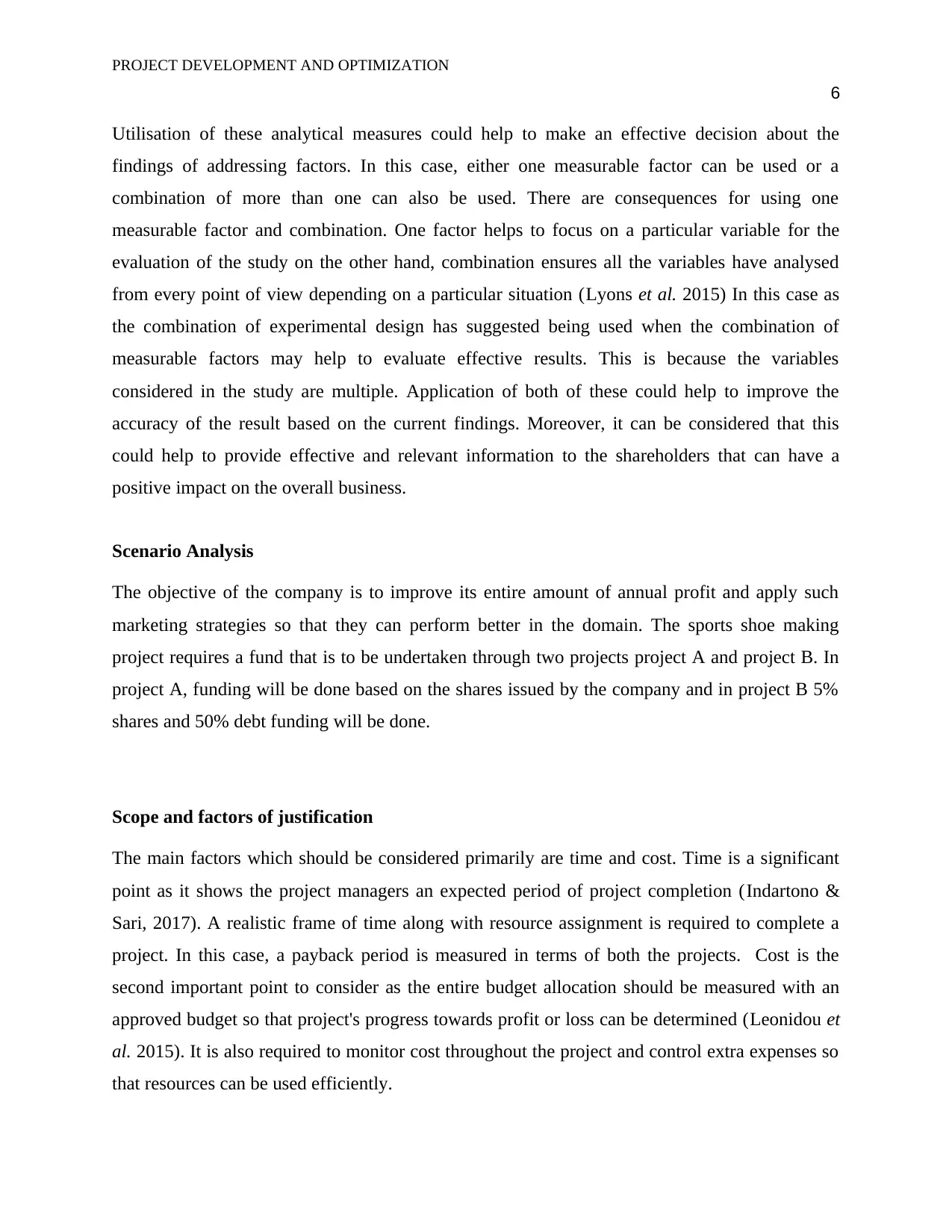
PROJECT DEVELOPMENT AND OPTIMIZATION
6
Utilisation of these analytical measures could help to make an effective decision about the
findings of addressing factors. In this case, either one measurable factor can be used or a
combination of more than one can also be used. There are consequences for using one
measurable factor and combination. One factor helps to focus on a particular variable for the
evaluation of the study on the other hand, combination ensures all the variables have analysed
from every point of view depending on a particular situation (Lyons et al. 2015) In this case as
the combination of experimental design has suggested being used when the combination of
measurable factors may help to evaluate effective results. This is because the variables
considered in the study are multiple. Application of both of these could help to improve the
accuracy of the result based on the current findings. Moreover, it can be considered that this
could help to provide effective and relevant information to the shareholders that can have a
positive impact on the overall business.
Scenario Analysis
The objective of the company is to improve its entire amount of annual profit and apply such
marketing strategies so that they can perform better in the domain. The sports shoe making
project requires a fund that is to be undertaken through two projects project A and project B. In
project A, funding will be done based on the shares issued by the company and in project B 5%
shares and 50% debt funding will be done.
Scope and factors of justification
The main factors which should be considered primarily are time and cost. Time is a significant
point as it shows the project managers an expected period of project completion (Indartono &
Sari, 2017). A realistic frame of time along with resource assignment is required to complete a
project. In this case, a payback period is measured in terms of both the projects. Cost is the
second important point to consider as the entire budget allocation should be measured with an
approved budget so that project's progress towards profit or loss can be determined (Leonidou et
al. 2015). It is also required to monitor cost throughout the project and control extra expenses so
that resources can be used efficiently.
6
Utilisation of these analytical measures could help to make an effective decision about the
findings of addressing factors. In this case, either one measurable factor can be used or a
combination of more than one can also be used. There are consequences for using one
measurable factor and combination. One factor helps to focus on a particular variable for the
evaluation of the study on the other hand, combination ensures all the variables have analysed
from every point of view depending on a particular situation (Lyons et al. 2015) In this case as
the combination of experimental design has suggested being used when the combination of
measurable factors may help to evaluate effective results. This is because the variables
considered in the study are multiple. Application of both of these could help to improve the
accuracy of the result based on the current findings. Moreover, it can be considered that this
could help to provide effective and relevant information to the shareholders that can have a
positive impact on the overall business.
Scenario Analysis
The objective of the company is to improve its entire amount of annual profit and apply such
marketing strategies so that they can perform better in the domain. The sports shoe making
project requires a fund that is to be undertaken through two projects project A and project B. In
project A, funding will be done based on the shares issued by the company and in project B 5%
shares and 50% debt funding will be done.
Scope and factors of justification
The main factors which should be considered primarily are time and cost. Time is a significant
point as it shows the project managers an expected period of project completion (Indartono &
Sari, 2017). A realistic frame of time along with resource assignment is required to complete a
project. In this case, a payback period is measured in terms of both the projects. Cost is the
second important point to consider as the entire budget allocation should be measured with an
approved budget so that project's progress towards profit or loss can be determined (Leonidou et
al. 2015). It is also required to monitor cost throughout the project and control extra expenses so
that resources can be used efficiently.
⊘ This is a preview!⊘
Do you want full access?
Subscribe today to unlock all pages.

Trusted by 1+ million students worldwide
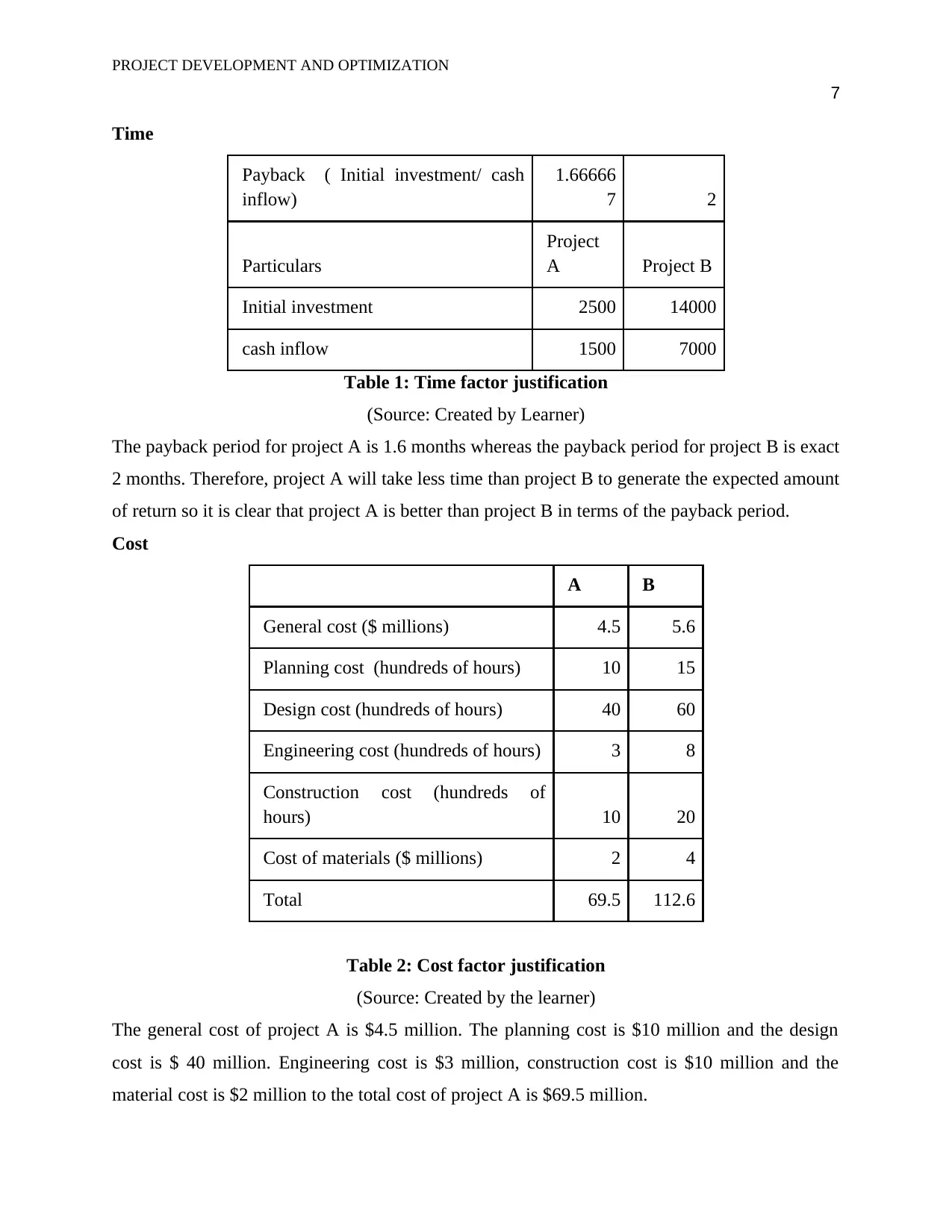
PROJECT DEVELOPMENT AND OPTIMIZATION
7
Time
Payback ( Initial investment/ cash
inflow)
1.66666
7 2
Particulars
Project
A Project B
Initial investment 2500 14000
cash inflow 1500 7000
Table 1: Time factor justification
(Source: Created by Learner)
The payback period for project A is 1.6 months whereas the payback period for project B is exact
2 months. Therefore, project A will take less time than project B to generate the expected amount
of return so it is clear that project A is better than project B in terms of the payback period.
Cost
A B
General cost ($ millions) 4.5 5.6
Planning cost (hundreds of hours) 10 15
Design cost (hundreds of hours) 40 60
Engineering cost (hundreds of hours) 3 8
Construction cost (hundreds of
hours) 10 20
Cost of materials ($ millions) 2 4
Total 69.5 112.6
Table 2: Cost factor justification
(Source: Created by the learner)
The general cost of project A is $4.5 million. The planning cost is $10 million and the design
cost is $ 40 million. Engineering cost is $3 million, construction cost is $10 million and the
material cost is $2 million to the total cost of project A is $69.5 million.
7
Time
Payback ( Initial investment/ cash
inflow)
1.66666
7 2
Particulars
Project
A Project B
Initial investment 2500 14000
cash inflow 1500 7000
Table 1: Time factor justification
(Source: Created by Learner)
The payback period for project A is 1.6 months whereas the payback period for project B is exact
2 months. Therefore, project A will take less time than project B to generate the expected amount
of return so it is clear that project A is better than project B in terms of the payback period.
Cost
A B
General cost ($ millions) 4.5 5.6
Planning cost (hundreds of hours) 10 15
Design cost (hundreds of hours) 40 60
Engineering cost (hundreds of hours) 3 8
Construction cost (hundreds of
hours) 10 20
Cost of materials ($ millions) 2 4
Total 69.5 112.6
Table 2: Cost factor justification
(Source: Created by the learner)
The general cost of project A is $4.5 million. The planning cost is $10 million and the design
cost is $ 40 million. Engineering cost is $3 million, construction cost is $10 million and the
material cost is $2 million to the total cost of project A is $69.5 million.
Paraphrase This Document
Need a fresh take? Get an instant paraphrase of this document with our AI Paraphraser
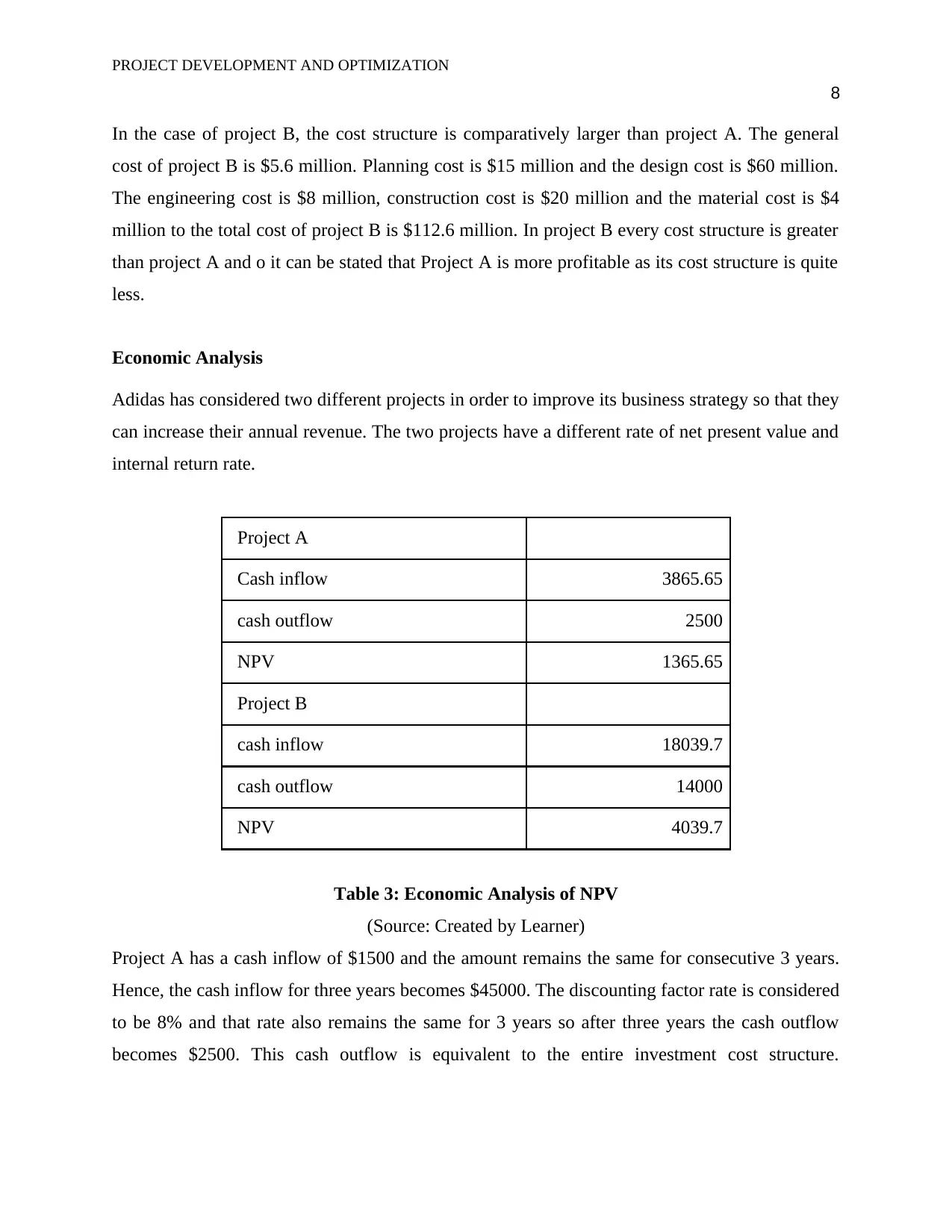
PROJECT DEVELOPMENT AND OPTIMIZATION
8
In the case of project B, the cost structure is comparatively larger than project A. The general
cost of project B is $5.6 million. Planning cost is $15 million and the design cost is $60 million.
The engineering cost is $8 million, construction cost is $20 million and the material cost is $4
million to the total cost of project B is $112.6 million. In project B every cost structure is greater
than project A and o it can be stated that Project A is more profitable as its cost structure is quite
less.
Economic Analysis
Adidas has considered two different projects in order to improve its business strategy so that they
can increase their annual revenue. The two projects have a different rate of net present value and
internal return rate.
Project A
Cash inflow 3865.65
cash outflow 2500
NPV 1365.65
Project B
cash inflow 18039.7
cash outflow 14000
NPV 4039.7
Table 3: Economic Analysis of NPV
(Source: Created by Learner)
Project A has a cash inflow of $1500 and the amount remains the same for consecutive 3 years.
Hence, the cash inflow for three years becomes $45000. The discounting factor rate is considered
to be 8% and that rate also remains the same for 3 years so after three years the cash outflow
becomes $2500. This cash outflow is equivalent to the entire investment cost structure.
8
In the case of project B, the cost structure is comparatively larger than project A. The general
cost of project B is $5.6 million. Planning cost is $15 million and the design cost is $60 million.
The engineering cost is $8 million, construction cost is $20 million and the material cost is $4
million to the total cost of project B is $112.6 million. In project B every cost structure is greater
than project A and o it can be stated that Project A is more profitable as its cost structure is quite
less.
Economic Analysis
Adidas has considered two different projects in order to improve its business strategy so that they
can increase their annual revenue. The two projects have a different rate of net present value and
internal return rate.
Project A
Cash inflow 3865.65
cash outflow 2500
NPV 1365.65
Project B
cash inflow 18039.7
cash outflow 14000
NPV 4039.7
Table 3: Economic Analysis of NPV
(Source: Created by Learner)
Project A has a cash inflow of $1500 and the amount remains the same for consecutive 3 years.
Hence, the cash inflow for three years becomes $45000. The discounting factor rate is considered
to be 8% and that rate also remains the same for 3 years so after three years the cash outflow
becomes $2500. This cash outflow is equivalent to the entire investment cost structure.
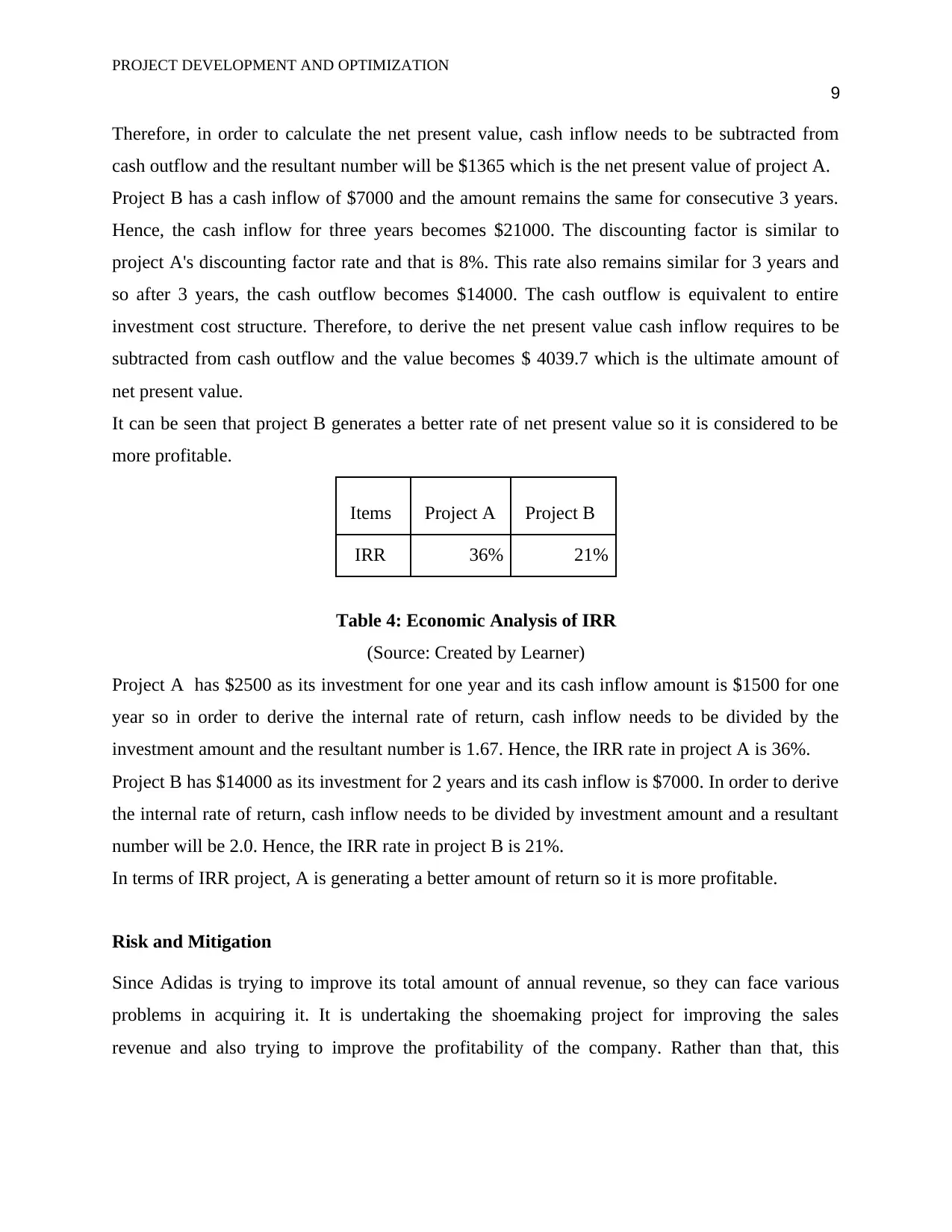
PROJECT DEVELOPMENT AND OPTIMIZATION
9
Therefore, in order to calculate the net present value, cash inflow needs to be subtracted from
cash outflow and the resultant number will be $1365 which is the net present value of project A.
Project B has a cash inflow of $7000 and the amount remains the same for consecutive 3 years.
Hence, the cash inflow for three years becomes $21000. The discounting factor is similar to
project A's discounting factor rate and that is 8%. This rate also remains similar for 3 years and
so after 3 years, the cash outflow becomes $14000. The cash outflow is equivalent to entire
investment cost structure. Therefore, to derive the net present value cash inflow requires to be
subtracted from cash outflow and the value becomes $ 4039.7 which is the ultimate amount of
net present value.
It can be seen that project B generates a better rate of net present value so it is considered to be
more profitable.
Items Project A Project B
IRR 36% 21%
Table 4: Economic Analysis of IRR
(Source: Created by Learner)
Project A has $2500 as its investment for one year and its cash inflow amount is $1500 for one
year so in order to derive the internal rate of return, cash inflow needs to be divided by the
investment amount and the resultant number is 1.67. Hence, the IRR rate in project A is 36%.
Project B has $14000 as its investment for 2 years and its cash inflow is $7000. In order to derive
the internal rate of return, cash inflow needs to be divided by investment amount and a resultant
number will be 2.0. Hence, the IRR rate in project B is 21%.
In terms of IRR project, A is generating a better amount of return so it is more profitable.
Risk and Mitigation
Since Adidas is trying to improve its total amount of annual revenue, so they can face various
problems in acquiring it. It is undertaking the shoemaking project for improving the sales
revenue and also trying to improve the profitability of the company. Rather than that, this
9
Therefore, in order to calculate the net present value, cash inflow needs to be subtracted from
cash outflow and the resultant number will be $1365 which is the net present value of project A.
Project B has a cash inflow of $7000 and the amount remains the same for consecutive 3 years.
Hence, the cash inflow for three years becomes $21000. The discounting factor is similar to
project A's discounting factor rate and that is 8%. This rate also remains similar for 3 years and
so after 3 years, the cash outflow becomes $14000. The cash outflow is equivalent to entire
investment cost structure. Therefore, to derive the net present value cash inflow requires to be
subtracted from cash outflow and the value becomes $ 4039.7 which is the ultimate amount of
net present value.
It can be seen that project B generates a better rate of net present value so it is considered to be
more profitable.
Items Project A Project B
IRR 36% 21%
Table 4: Economic Analysis of IRR
(Source: Created by Learner)
Project A has $2500 as its investment for one year and its cash inflow amount is $1500 for one
year so in order to derive the internal rate of return, cash inflow needs to be divided by the
investment amount and the resultant number is 1.67. Hence, the IRR rate in project A is 36%.
Project B has $14000 as its investment for 2 years and its cash inflow is $7000. In order to derive
the internal rate of return, cash inflow needs to be divided by investment amount and a resultant
number will be 2.0. Hence, the IRR rate in project B is 21%.
In terms of IRR project, A is generating a better amount of return so it is more profitable.
Risk and Mitigation
Since Adidas is trying to improve its total amount of annual revenue, so they can face various
problems in acquiring it. It is undertaking the shoemaking project for improving the sales
revenue and also trying to improve the profitability of the company. Rather than that, this
⊘ This is a preview!⊘
Do you want full access?
Subscribe today to unlock all pages.

Trusted by 1+ million students worldwide
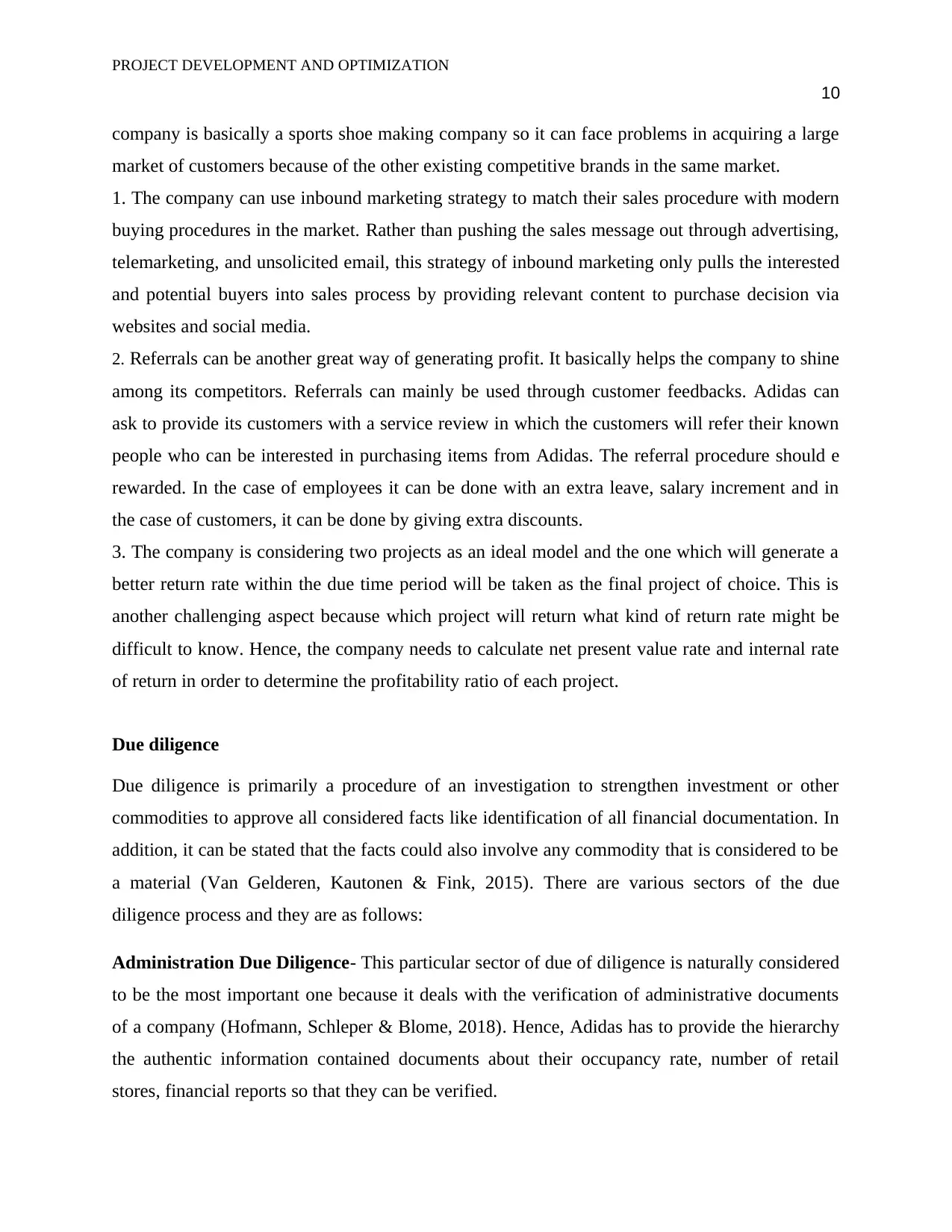
PROJECT DEVELOPMENT AND OPTIMIZATION
10
company is basically a sports shoe making company so it can face problems in acquiring a large
market of customers because of the other existing competitive brands in the same market.
1. The company can use inbound marketing strategy to match their sales procedure with modern
buying procedures in the market. Rather than pushing the sales message out through advertising,
telemarketing, and unsolicited email, this strategy of inbound marketing only pulls the interested
and potential buyers into sales process by providing relevant content to purchase decision via
websites and social media.
2. Referrals can be another great way of generating profit. It basically helps the company to shine
among its competitors. Referrals can mainly be used through customer feedbacks. Adidas can
ask to provide its customers with a service review in which the customers will refer their known
people who can be interested in purchasing items from Adidas. The referral procedure should e
rewarded. In the case of employees it can be done with an extra leave, salary increment and in
the case of customers, it can be done by giving extra discounts.
3. The company is considering two projects as an ideal model and the one which will generate a
better return rate within the due time period will be taken as the final project of choice. This is
another challenging aspect because which project will return what kind of return rate might be
difficult to know. Hence, the company needs to calculate net present value rate and internal rate
of return in order to determine the profitability ratio of each project.
Due diligence
Due diligence is primarily a procedure of an investigation to strengthen investment or other
commodities to approve all considered facts like identification of all financial documentation. In
addition, it can be stated that the facts could also involve any commodity that is considered to be
a material (Van Gelderen, Kautonen & Fink, 2015). There are various sectors of the due
diligence process and they are as follows:
Administration Due Diligence- This particular sector of due of diligence is naturally considered
to be the most important one because it deals with the verification of administrative documents
of a company (Hofmann, Schleper & Blome, 2018). Hence, Adidas has to provide the hierarchy
the authentic information contained documents about their occupancy rate, number of retail
stores, financial reports so that they can be verified.
10
company is basically a sports shoe making company so it can face problems in acquiring a large
market of customers because of the other existing competitive brands in the same market.
1. The company can use inbound marketing strategy to match their sales procedure with modern
buying procedures in the market. Rather than pushing the sales message out through advertising,
telemarketing, and unsolicited email, this strategy of inbound marketing only pulls the interested
and potential buyers into sales process by providing relevant content to purchase decision via
websites and social media.
2. Referrals can be another great way of generating profit. It basically helps the company to shine
among its competitors. Referrals can mainly be used through customer feedbacks. Adidas can
ask to provide its customers with a service review in which the customers will refer their known
people who can be interested in purchasing items from Adidas. The referral procedure should e
rewarded. In the case of employees it can be done with an extra leave, salary increment and in
the case of customers, it can be done by giving extra discounts.
3. The company is considering two projects as an ideal model and the one which will generate a
better return rate within the due time period will be taken as the final project of choice. This is
another challenging aspect because which project will return what kind of return rate might be
difficult to know. Hence, the company needs to calculate net present value rate and internal rate
of return in order to determine the profitability ratio of each project.
Due diligence
Due diligence is primarily a procedure of an investigation to strengthen investment or other
commodities to approve all considered facts like identification of all financial documentation. In
addition, it can be stated that the facts could also involve any commodity that is considered to be
a material (Van Gelderen, Kautonen & Fink, 2015). There are various sectors of the due
diligence process and they are as follows:
Administration Due Diligence- This particular sector of due of diligence is naturally considered
to be the most important one because it deals with the verification of administrative documents
of a company (Hofmann, Schleper & Blome, 2018). Hence, Adidas has to provide the hierarchy
the authentic information contained documents about their occupancy rate, number of retail
stores, financial reports so that they can be verified.
Paraphrase This Document
Need a fresh take? Get an instant paraphrase of this document with our AI Paraphraser
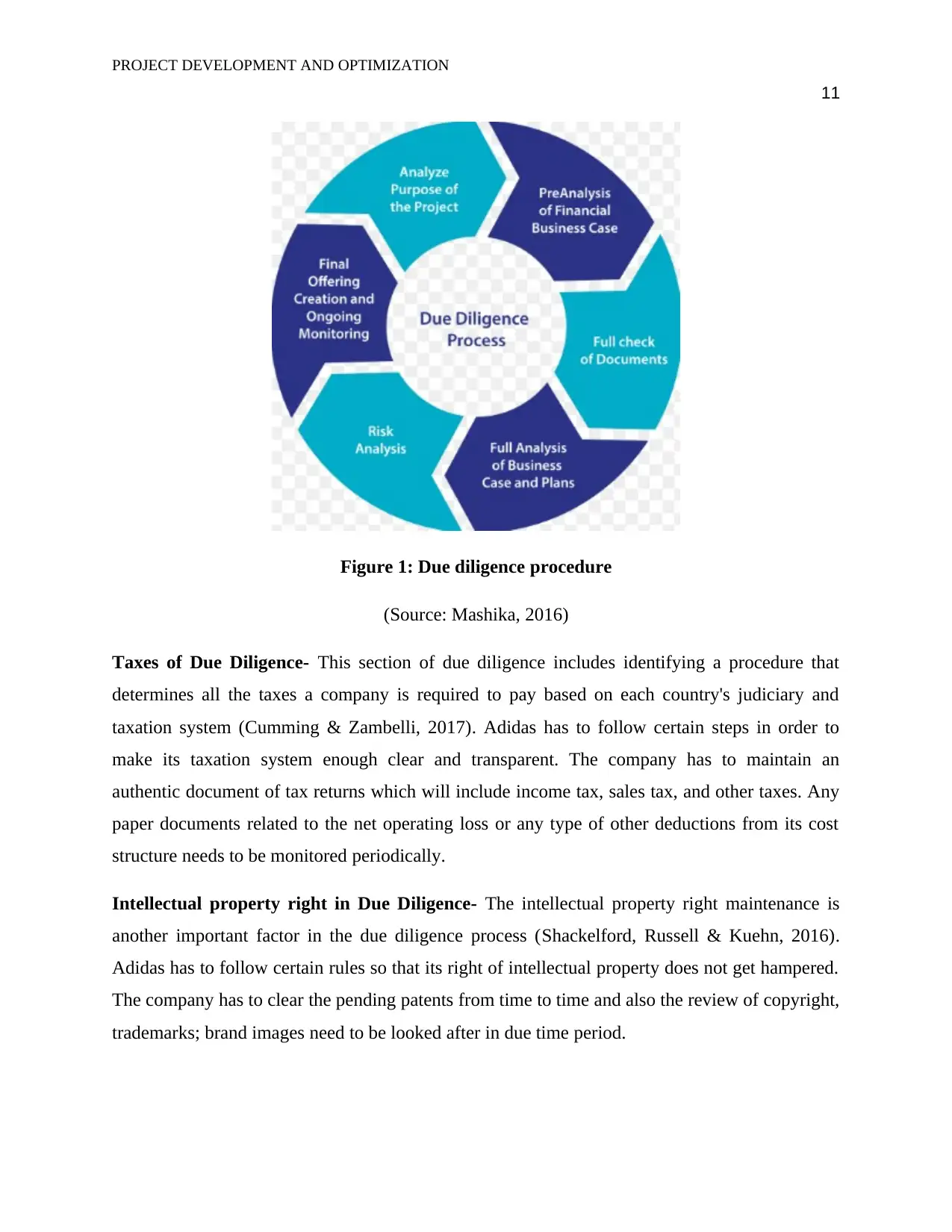
PROJECT DEVELOPMENT AND OPTIMIZATION
11
Figure 1: Due diligence procedure
(Source: Mashika, 2016)
Taxes of Due Diligence- This section of due diligence includes identifying a procedure that
determines all the taxes a company is required to pay based on each country's judiciary and
taxation system (Cumming & Zambelli, 2017). Adidas has to follow certain steps in order to
make its taxation system enough clear and transparent. The company has to maintain an
authentic document of tax returns which will include income tax, sales tax, and other taxes. Any
paper documents related to the net operating loss or any type of other deductions from its cost
structure needs to be monitored periodically.
Intellectual property right in Due Diligence- The intellectual property right maintenance is
another important factor in the due diligence process (Shackelford, Russell & Kuehn, 2016).
Adidas has to follow certain rules so that its right of intellectual property does not get hampered.
The company has to clear the pending patents from time to time and also the review of copyright,
trademarks; brand images need to be looked after in due time period.
11
Figure 1: Due diligence procedure
(Source: Mashika, 2016)
Taxes of Due Diligence- This section of due diligence includes identifying a procedure that
determines all the taxes a company is required to pay based on each country's judiciary and
taxation system (Cumming & Zambelli, 2017). Adidas has to follow certain steps in order to
make its taxation system enough clear and transparent. The company has to maintain an
authentic document of tax returns which will include income tax, sales tax, and other taxes. Any
paper documents related to the net operating loss or any type of other deductions from its cost
structure needs to be monitored periodically.
Intellectual property right in Due Diligence- The intellectual property right maintenance is
another important factor in the due diligence process (Shackelford, Russell & Kuehn, 2016).
Adidas has to follow certain rules so that its right of intellectual property does not get hampered.
The company has to clear the pending patents from time to time and also the review of copyright,
trademarks; brand images need to be looked after in due time period.
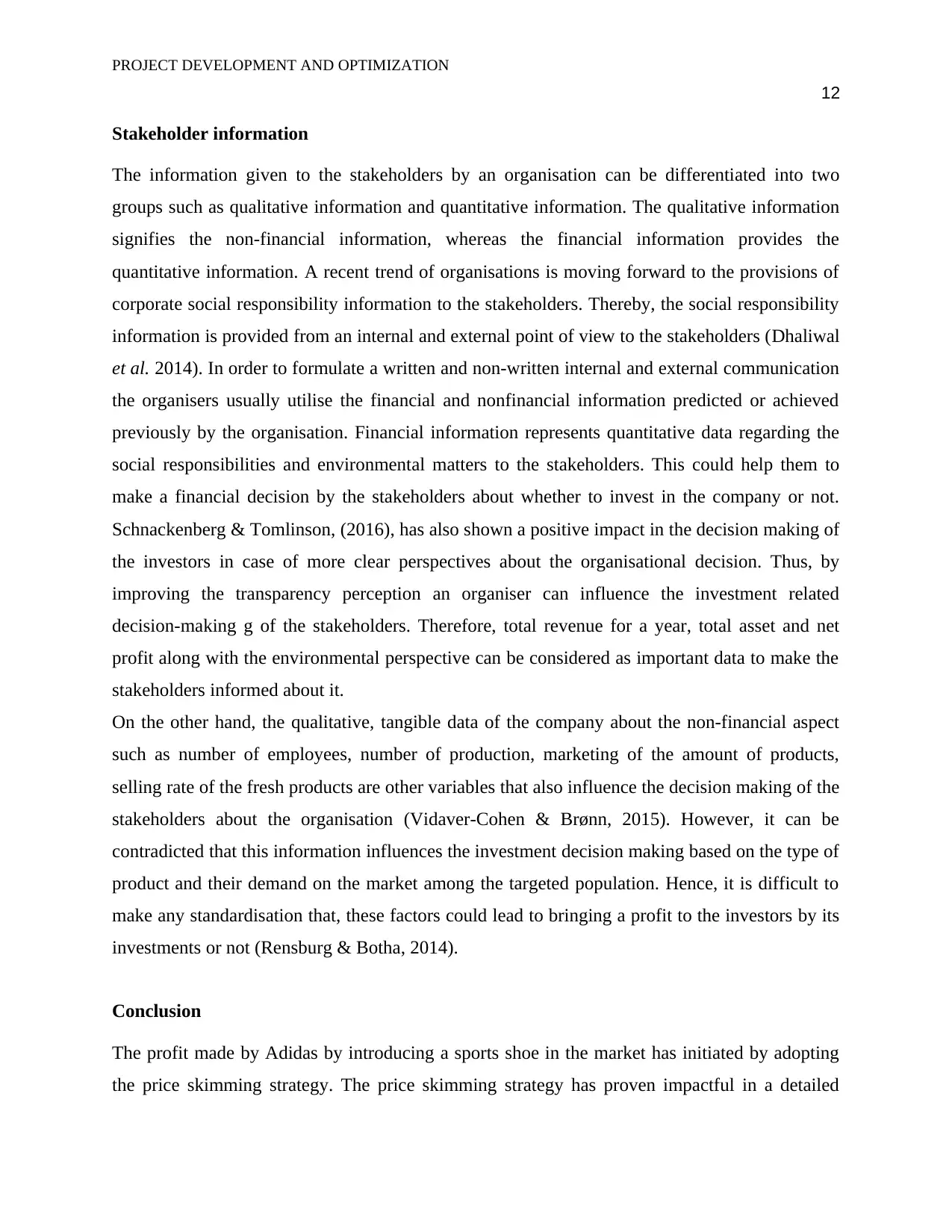
PROJECT DEVELOPMENT AND OPTIMIZATION
12
Stakeholder information
The information given to the stakeholders by an organisation can be differentiated into two
groups such as qualitative information and quantitative information. The qualitative information
signifies the non-financial information, whereas the financial information provides the
quantitative information. A recent trend of organisations is moving forward to the provisions of
corporate social responsibility information to the stakeholders. Thereby, the social responsibility
information is provided from an internal and external point of view to the stakeholders (Dhaliwal
et al. 2014). In order to formulate a written and non-written internal and external communication
the organisers usually utilise the financial and nonfinancial information predicted or achieved
previously by the organisation. Financial information represents quantitative data regarding the
social responsibilities and environmental matters to the stakeholders. This could help them to
make a financial decision by the stakeholders about whether to invest in the company or not.
Schnackenberg & Tomlinson, (2016), has also shown a positive impact in the decision making of
the investors in case of more clear perspectives about the organisational decision. Thus, by
improving the transparency perception an organiser can influence the investment related
decision-making g of the stakeholders. Therefore, total revenue for a year, total asset and net
profit along with the environmental perspective can be considered as important data to make the
stakeholders informed about it.
On the other hand, the qualitative, tangible data of the company about the non-financial aspect
such as number of employees, number of production, marketing of the amount of products,
selling rate of the fresh products are other variables that also influence the decision making of the
stakeholders about the organisation (Vidaver-Cohen & Brønn, 2015). However, it can be
contradicted that this information influences the investment decision making based on the type of
product and their demand on the market among the targeted population. Hence, it is difficult to
make any standardisation that, these factors could lead to bringing a profit to the investors by its
investments or not (Rensburg & Botha, 2014).
Conclusion
The profit made by Adidas by introducing a sports shoe in the market has initiated by adopting
the price skimming strategy. The price skimming strategy has proven impactful in a detailed
12
Stakeholder information
The information given to the stakeholders by an organisation can be differentiated into two
groups such as qualitative information and quantitative information. The qualitative information
signifies the non-financial information, whereas the financial information provides the
quantitative information. A recent trend of organisations is moving forward to the provisions of
corporate social responsibility information to the stakeholders. Thereby, the social responsibility
information is provided from an internal and external point of view to the stakeholders (Dhaliwal
et al. 2014). In order to formulate a written and non-written internal and external communication
the organisers usually utilise the financial and nonfinancial information predicted or achieved
previously by the organisation. Financial information represents quantitative data regarding the
social responsibilities and environmental matters to the stakeholders. This could help them to
make a financial decision by the stakeholders about whether to invest in the company or not.
Schnackenberg & Tomlinson, (2016), has also shown a positive impact in the decision making of
the investors in case of more clear perspectives about the organisational decision. Thus, by
improving the transparency perception an organiser can influence the investment related
decision-making g of the stakeholders. Therefore, total revenue for a year, total asset and net
profit along with the environmental perspective can be considered as important data to make the
stakeholders informed about it.
On the other hand, the qualitative, tangible data of the company about the non-financial aspect
such as number of employees, number of production, marketing of the amount of products,
selling rate of the fresh products are other variables that also influence the decision making of the
stakeholders about the organisation (Vidaver-Cohen & Brønn, 2015). However, it can be
contradicted that this information influences the investment decision making based on the type of
product and their demand on the market among the targeted population. Hence, it is difficult to
make any standardisation that, these factors could lead to bringing a profit to the investors by its
investments or not (Rensburg & Botha, 2014).
Conclusion
The profit made by Adidas by introducing a sports shoe in the market has initiated by adopting
the price skimming strategy. The price skimming strategy has proven impactful in a detailed
⊘ This is a preview!⊘
Do you want full access?
Subscribe today to unlock all pages.

Trusted by 1+ million students worldwide
1 out of 17
Related Documents
Your All-in-One AI-Powered Toolkit for Academic Success.
+13062052269
info@desklib.com
Available 24*7 on WhatsApp / Email
![[object Object]](/_next/static/media/star-bottom.7253800d.svg)
Unlock your academic potential
Copyright © 2020–2025 A2Z Services. All Rights Reserved. Developed and managed by ZUCOL.





